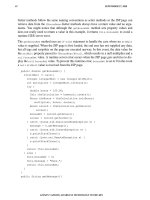head first java second edition phần 8 ppt
Bạn đang xem bản rút gọn của tài liệu. Xem và tải ngay bản đầy đủ của tài liệu tại đây (3.32 MB, 68 trang )
saving objects
Versio"
IP:
A
Jig
Serializatio"
&otcha
Now you've
seen
that
I
/O
inJava
is actually pretty simple, especially
if
you stick to
the
most
common
connection/chain
combinations.
But
there's
one
issue you
might
really
care
about.
Version Control is
crucial!
!fyou
serialize
an
object, you
must
have
the
class in
order
to
deserialize
and
use
the
object. OK, that's obvious.
But
what
might
be less obvious is what
happens
if
you changethe classin
the
meantime?
Yikes.
Imagine
trying to
bring
back
a
Dog
object
when
one
of
its instance variables (non-transient)
has
changed
from
a
double
to a String.
That
violatesJava's type-safe sensibilities
in
a Big
Way.
But
that
's
not
the
onl
y
change
that
might
hurt
compatibility.
Think
about
the
following:
Changes
to
a
class
that
can
hurt
deseriallzatlon:
Deleting an instance variable
Changing
the
declared
type
of
an instance variable
Changing
a
non-transient
instance variable to
transient
Moving a class
up
or
down
the
inheritance
hierarchy
Changing
a class (anywhere in
the
object
graph)
from
Serializable
to
not
Serializable (by removing 'implements Serializable' from a
class declaration)
Changing
an
instance variable to static
•
•
•
•
You
write
a Dog class
10U
Ol
1011 01 ".
\1"'1
1010 1
000010
·· \
,,~S\()Y\·
v
~~;~o
10
1
Q taSS
1010101
~
~~
~~~~~O
l
~;Ar;
Dog
.class
You serialize a Dog
object
using
that
class
You change
the
Dog class
~
~~i~
~
\ .
\D
~:
~
:
O
~ ~
'
:
tlas
s
>JeYSIO'l\
Ol 010 1.
;
o
~~
~ o
:~:
o
:H=12-~
1. 0 1. 10 10
Dog.c1ass
You deserialize a Dog
object
using
the
changed class
Changes
to
a
class
that
are
usually
OK:
Adding
new
instance
variables to
the
class (existing objects will
deserialize with
default
values for
the
instance variables they
didn't
have
when
they w
ere
serialized)
Adding
classes to
the
inheritance
tree
Removing classes
from
the
inheritance
tree
Changing
the
access level
of
an instance variable has
no
affect
on
the
ability
of
deserialization to assign a value to
the
variable
Ch
anging
an
instance variable
from
transient
to
non-transient
(previously-serialized objects will simply have a
default
value
for
the
previously-transient variables)
460
chapte r 14
101101
1
0U
Ol ' "
101000010
101
0 10 0
01.010 1
C
100001 1010
o 00110101
1. 0 1 10 10
Dog.class
t\a
ss
>Jeys',OYl'IS
:H=12-~
• Serailization fails!!
The
JVM
says,
"you can
't
teach an old Dog new code".
Usi.,g
the
serialVersio.,UIP
Each
time an object is serialized.
the
object
(including
every
object
in its
graph)
is 'stampe
d'
with a version
ID
number
for
the
object's class.
The
ill
is called
the
serialVersionUlD,
and
it's
computed
based on
information
about
the
class
structure
. As an object is
being
deserialized,
if
the
class has
changed
since
the
object was serialized,
the
class
could
have a different
serialVersionUID,
and
deserialization
will faill
But
you
can
control this.
If
you
think
there
Is
ANY
possibility
that
your
class
might
evolve,
put
a
serial
version
ID
In
your
class.
When
Java tries to deserialize an object, it
compares
the
serialized object's serialVersionUID with
that
of
the
class the
JVM
is using for deserializing
the
object
For
example,
ifa
Dog
instance was serialized with an
ill
of,
say
23 (in reality a serialVersionUID is
much
longer).
when
theJVM
deserial
izes
the
Dog
object it will first
compare
the
Dog object serialVersionUID with
the
Dog
class serialVersionUID.
If
the
two
numbers
don't
match,
rhejVM
assumes
the
class is
not
compatible
with
the
previously-serialized object,
and
you'll
get
an
exception
during
deserialization.
So,
the
solution
is to
put
a serialVersionUID
in
your
class,
and
then
as
the
class evolves,
the
serialVersionUID will
remain
the
same
and
the
JVM
will say. "OK, cool,
the
class is compatible with this
serialized object." even
though
the
class has actually
changed.
This
works
()1lly
if
you're
careful with your class
changes! In
other
words.
YQU
are
taking
responsibility
for
any issues
that
come
up
when
an
older
object
is
brought
back to life with a
newer
class .
To
get
a serialVersionUID for a class, use
the
serialver
tool
that
ships with yourJava
development
kit.
serialization
and
file
110
When
you
think
your
class
might
evolve
after
someone
has
serialized
objects
from
it
•••
@ Use.
the
serialver
command-line
too'
to
get
the
version ID
for
your closs
CD
Paste
the
output
into your closs
public
class
Dog {
long
.erialVersionOZD
-
-6849194410154667110L;
private
Strinq
name;
private
int
size
;
/ /
method
code
here
~
Be
sure
that
when you make changes to
the
closs, you
take
responsibility in your
code
for
the
consequences of
the
changes
you made
to
the
clossl
For example, be
sure
that
your new Dog closs can deal with
an
old Dog being
deserialized
with
default
values
for
i
nst
ance variables
added
to
the
doss
after
the
Dog was
serialized
.
you
ar
e here
~
461
Code
Kitchen
'*
*
Code
Kitchen
Let's
mak
the BeatBoxsave
and
restore our lavorite pattern
462
chapter
14
for
(int
i =
0;
i <
256;
i++)
{
serialization and file I/O
SavinG
a
'eatJox
pattern
Remember, in
the
BeatBox, a
drum
pattern
is
nothing
more
than
a
bunch
of
checkboxes.
When
it's time to play
the
sequence,
the
code
walks
through
the
checkboxes to figure
out
which
drums
sounds
are
playing at
each
of
the
16
beats. So to save a
pattern,
all we
need
to do is save
the
state
of
the
checkboxes.
We
can
make
a simple
boolean
array,
holding
the
state
of
each
of
the
256
checkboxes. An array object is serializable as
long
as
the
things in
the
array
are
serializable, so we'll have
no
trouble
saving
an
array
of
boo
leans.
To
load
a
pattern
back
in, we
read
the
single
boolean
array object (deserialize
it),
and
restore
the
checkboxes. Most
of
the
code
you've already
seen
, in
the
Code
Kitchen
where
we
built
the
BeatBox GUI, so in this chapter, we
look
at
only
the
save
and
restore code.
This CodeKitchen gets us ready for
the
next
chapter,
where
instead
of
writing
the
pattern
to a
file,
we
send
it over
the
networkto
the
server.
And
instead
of
loading
a
pattern
in from a file, we
get
patterns
from
the
server,
each
time a
participant
sends
one
to
the
server.
Serializing
a
pattern
This is an
inner
t\ass
i'llSide
t.he
Beat.Bo~
zede.
public
class
MySendListener
implements
ActionListener
{
l'
\.,,,
t.he
It.all
happens
,hen
"he
~er
" . s
public
void
actionPerformed
(ActionEvent
a)
{~b~Hon
and
t.he
Ad
:ionE.'Ient.
.{
\res.
boolean
[]
checkboxState
=new
boolean
[256];
t
Zta
rbooleatl
array to
hold
t.he
01" eath
the'kbo~
.
JCheckBox
check
= (JCheckBox)
if
(check.isSelected(»
{
checkboxState[i]
=
true;
checkboxList.get(i);
Walk
t.hro~
h
t.h
(ArrayL
ist.
got e
thetkbo~List
get
t.he
state
thetkbo~
s)
,
atld
add
it
to t
0+
eath O
tl
e,
and
he
boo/
ea
tl
ar
ray.
try
{
FileOUtputStream
fileStream
= new
FileOUtputStream(new
File("Checkbox.ser"»;
ObjectOUtputStream
os
= new
ObjectOUtputStream(fileStream)
;
os.writeObject(checkboxState);
catch(Exception
ex)
{
ex.printStackTrace();
}
II
close
method
II
close
inner
class
you are here).
463
deserlallzlng the pattern
Resfori.,g
a
Jea1tox
patter"
This is pretty
much
the
save in reverse
read
the
boolean
array
and
use it
to restore
the
state
of
the
GUI checkboxes, It all
happens
when
the
user
hits
the "restore"
'button
.
Restoring a
pattern
public
class
MyReadInListener
impleJDenta
ActionLiataner
publiC
void
actionPerfor.med(ActionEvent
a)
boolean
[]
checkboxState
:;;;;
null;
try
(
FilelnputStream
filaIn:;;;;
new
Filelnputstream(new
File("Checkbox.aer"»;
ObjectInputstream
is
•
new
ObjectInputStream(fileIn)
;
checkboxState
=
(boolean
[])
is.
readObject
() ;
t
Rao
-the
s"",~'e
~jed:
i". the
kil~~e
boolea"
array>
o"d
ta1-t
ItW . 0
catch
(Exception
ex)
(ex.
printstackTrac.
() ; }
boolea"
arr0'i(Yl:1"etI'w.
ytaoObjett
\'"d~."s
a yet
~a te
ok
~e
Ob}et
for
(int
i
:;;;;
0;
i <
256;
i++) (
JCb.eckBox
check
:::r
(JCheckBox)
if
(eheckboxState
till
(
ohaek.satsalected(trua)
;
}
elae
(
eheck.aetselected{false);
aheokboxLillt.
get
(1)
;
sequencer.stop();
buildTrackAndStart();
} I I
close
I118thod
II
close
inner
class
rpen
your
penCiI
,
This version has a
huge
IImltatlonl When you
hit
the
"serlatlzelt"
button,
It
serlaIIzesautomatlca
lIy,to a file named "Checkbox.ser" (which gets created If It
doesn't exist).But each
time
you save,you overwrite
the
previously-saved flIe.
Improve
the
save and restore feature, by Incorporating a JFlleChooser so
that
you can name and save as many
different
patterns as you like, and loadlrestore
from
any
of
you r prevIously-saved
pattern
flies.
464
chapter
14
~yourpenCii
serialization and file
110
can
they
he
saved?
Which
of
these do you
think
are,or should be,
serlallzable? If
not
,
why
not?
Not
meaningful7
Security rls
k7
Only works
for
the
CUTrent
execution
of
the
JVM?Make your best guess,
without
looking
it
up in
the
API.
Object
type
Serlallzable?
If
not,
why
not?
Object
Ves
I No
String Yes I No
File Yes
I No
Date Ves
I No
OutputStream Yes
I No
JFrame
Yes
I No
Integer Yes
I No
System
Ves
I No
Whars
Legalil
:lrcle
the
code
fragments
nat
would
compile
(assuming
:hey're
with
In
a
lega
I
dass).
KEEP
+-
RIGHT
FileReader
fileReadar
~
new
FileReader()
i
BufferedReader
reader
:: new
BufferedReader
(fileReader)
;
FileC>utputStream
f :: new
FileOutputStream
(new
File
("roo
.
se.r")
) ;
ObjectOutputstream
08
::
new
ObjectOutputStream(f)
;
BufferedReader
reader::
new BufferedReader(new FileReade.r(file)) ;
String
line
=
null;
whila
(line
•
reader.readLine())
!=
null)
(
malcecard(line)
;
ObjectInputStream
is
=
new
ObjectInputstream
(new
Fil&Outputstream("Game.
ser")) ;
GameCharacter
oneAgain
=
(Gamecharacter)
is.readObject();
you
are
here
~
465
exercise:
True
or
False
This chapter explored
the
wonerful world of
Java
110.
YourJob Isto decide whether each
of the following lID-related statements is
true or false.
1. Serialization is
appropriate
when
saving
data
for
non-java
programs
to use.
2.
Object
state
can
be saved only by using serialization.
3.
ObjectOutputStream
is a class
used
to save serialized objects.
4.
Chain
streams
can
be
used
on
their
own or
with
connection
streams.
5. A single call to writeObjectO
can
cause many objects to be saved.
6. All classes
are
serializable by default.
7.
The
transient
modifier
allows
you
to
make
instance variables serializable.
8.
If
a superclass is
not
serializable
then
the
subclass
can't
be serializable.
9.
When
objects
are
deserialized, they
are
read
back in last-in, first
out
sequence.
10.
When
an object is deserialized, its
constructor
does
not
run.
11.
Both
serialization
and
saving to a text file
can
throw
exceptions.
12. BufferedWriters
can
be
chained
to FileWriters.
13. File objects
represent
files,
but
not
directories.
14. You
can't
force a
buffer
to
send
its
data
before
it's full.
]5.
Both
file
readers
and
file writers
can
be buffered.
16.
The
String
splitO
method
includes
separators
as tokens in
the
result array.
17.
Any
change
to a class breaks previously serialized objects
of
that
class.
466
chapter
14
-
CJ
u serialization and file
110
o e
lYlaonets
This one's tricky,
~
we
promoted
it from an Exerciseto full Puzzle status.
Reconstruct the code snippets to make a working
Java
program that
produces the
output
listed below? (You
might
not need all of
the
magnets,
and you may reuse a magnet more than once.)
return
Zi
short
getZ
()
{
009.
close
( ) :
e.printStackTrace()i
fos
= new
FileOutputstrearn
(
"drr,se r " ) i
FileOutputs
t r eam
~
seriali'Zabl
e
{
class
DungeonGame
implements
ObjectlnputStream
ois
= new
ObjectlnputStream(fis);
int
geU()
{
return
Xi
System.out.println(d.getX()+d.getY()+d.getZ())i
Filelnputstream
fis = new ubl ic
int
x = 3;
FilelnputStream("dg.ser")j
ransient
long y = 4;
private
short
z = 5;
long
getY()
{
return
y;
class
D
ungeOnTest
<
ois
,
close
( ) ;
fos.writeObject(d);
import
java.io'~i
~
••
"I
}
catch
(Exception
e)
{
d
= (DungeonGame)
ois.readObject()j
you are
her
e
~
467
'd
main(String
I J
arg9)
{
public
static
vo~
d
DUngeonGame():
DungeonGame
= new
ObjectOutputstream
009 = new
ObjectOutputStream(fos):
oos
.writeObject(d);
exercise solu
tions
1. Serialization is
appropriate
when
saving
data
for
non:Java
programs
to use.
False
2.
Object
state
can
be
saved
only
by
using
serialization.
False
3.
ObjectOutputStream
is a class
used
to save serialized objects. True
4.
Chain
streams
can
be
usedon
their
own
or
with
connection
streams.
False
5. A single call to writeObjectO
can
cause
many
objects to be saved. True
6. All classes
are
serializable by default.
False
7.
The
transient
modifier
allows you to
make
instance
variables serializable.
False
8.
If
a superclass is
not
serializable
then
the
subclass
can't
be
serializable.
False
9.
When
objects
are
deserialized they
are
read
back
in last-in, first
out
sequence.
False
10.
When
an
object is deserialized, its
constructor
does
not
run
. True
11.
Both
serialization
and
saving to a
text
file
can
throw
exceptions. True
12. BufferedWriters
can
be
chained
to FileWriters. True
13. File objects
represent
files,
but
not
directories.
False
14. You
can't
force a
buffer
to
send
its
data
before
it's full.
False
15.
Both
file
readers
and
file writers
can
optionally
be
buffered. True
16.
The
String
splitf)
method
includes
separators
as
tokens
in
the
result
array.
False
17. Any
change
to a class breaks previously serialized objects
of
that
class.
False
468 ch
apter
14
F
it
~
~
W1~
Help
Es:apo
\ java
DungeonTest
12
8
serialization
and
file
110
class
DungeonGame
implements
Serializable
{
public
int
x =
3;
transient
long
y =
4:
private
short
z =
5:
int
getX()
{
return
Xj
}
long
gety()
{
return
Yj
}
short
getZ()
{
return
2:
}
}
class
DungeonTest
{
public
static
void
main(String
[)
args)
(
DungeonGame d = new DungeonGame{)j
System.out.println(d'getX()
+
d.getY()
+
d.getZ{»j
try
(
FileOutputStream
fOB
= new
FileOutputStream{Udg.ser
H
) :
ObjectOutputStream
oos
= new
ObjectOutputStream(foB)j
oos.writeObject(d);
oos.close():
FilelnputStream
fis = new
FilelnputStream(Udg.ser
n
) :
ObjectlnputStream
ois
= new
ObjectlnputStrearn{fis):
d = (DungeonGame)
ois.readObject();
ois.close();
catch
(Exception
e)
{
e.printStackTrace()j
)
system.out.println(d.getX()
+
d.getY{)
+
d.getZ{»;
}
you
are
here.
469
15 networking and threads
Make
a
Connection
Connect with the outside world. Your Javaprogram can reach
out
and touch a
program on another machine. It's easy. All the low-level networking details are taken care of by
classes
In the java.net library. One of
Java's
big benefits is that sending and receiving data over
a network IsJustI/O
with
a slightly dIfferent connection stream at the end of the chain. If you've
got
a BufferedReader.you can read.And the BufferedReader could care less if the data came
out
of a file or flew down an ethernet cable.In this chapter we'll connect to the outside world
with
sockets.We'll make cllentsockets.We'll make
server
sockets.We'll rnake
clients
and
servers.
And we'll make them talk to each other. Before the chapter's done, you'll have a fully-functional,
multithreaded chat client. Old we just say
multithreaded?
Yes,
now you will learn the secret of
how
to talk
to
Bob while simultaneously listening to Suzy.
this is a
new
cha
pter 471
tbo)(. chat
You're working on a
computer
game .You
and
your team
are doing the
sound
design for each
part
of
the game.
Using a 'chat' version of the Beat
'Box,
your
team
can
collaborate-You
can send a
beat
pattern
along with
your
chat
message,
and
everybody
in
the
Beat
BB:O"~C:h:a:t
__
-:r~~~;si~~~@~c::~~;1
getS
.i~
So
yO,u
don't
just
get to
rtad\
th
d
e
othder.
""'\<IO.sl'I"
•
0>"
"I<.t
pa",clpa.
lS
",,,sages.
yoU
gel 10
oa
an
e
-
;;;;.<""
pl<ry
a
bea
l
pattern s,,,,ply
by chclcing the , - '
<en
me
"'"
ee
,.
message in the incoming messages area.
~
~
~
In
this chapter we're going
10
learn
what
,t
Go
,.f'·
_t
\t \ 1\
t''-
l'
\\
to\!.
. . ' '
.'-'
,.
"",
,." ,"-,
takes 10
",ake
a c
hat
chenl
hke
th"
.We're oc ,,.n "
,<t.
"""
even going
10
,earn
a
hlde
.boUI
",aking
a
If
>;'f""'"
<1'
-;
cba
IS,,"'"
We'nsave the
fun
Beat
Be'
Chat
t: ',
In
"
r\~
"'"
for the
Code
lGochen.
but
in mis chapter you \
00
""""
",iUwn"" Ludicrously Si",ple
Chat
Client
and
t"'
'''''
Very Si",ple
Chat
Se",er
that
send
and
,eceive
~~
""
,.,fI'''''''
"'''
m"",g'"
<;t,
s."
""",
472
chapter
'\5
networking
and
threads
Chat
Program
Overview
The
Client
has
to
know
ahoutthe
Server.
The
Server
has
to
know
about
ALL
the
Clienti.
How
it
Works:
Client C
Client A
Server
Server
~V~,
I'd
lik~
to
l.o9I~t
- totht
t~
stHite
Client A
Client B
G The server makes a
connection and adds
the
client
to
the
list
of
participants
e Another client connects
o Client connects to
the
server
o Client A sends a
message
to
the
chat service
"Who
took
~
lava
liMf
__
1
-
~
My
OOhtl
f
-
Client A
-~~
I
~
.
I
~.
'
Server
o The server d
istributes
the
message
to ALL participants
(including
the
original sender)
Client A
Server
Client B
you
are
here
~
473
socketconnecllons
The
three
things we have to
learn
to
get
the
client working
are
:
1) How to establish
the
initial connection between
the
client
and
server
2) How
to
send
messages
UJ
the
server
S) How
to receive messagesjrom
the
server
There's
a lot
of
low-level
stuff
that
has to
happen
for these things to work. But
we're
lucky, because the Java API networking package (java
.net)
makes it a piece
of
cake
for
programmers.
You'll see a lot
more
GUI
code
than
networking
and
I/O
code.
And
that's
not
all.
Lurking
within
the
simple
chat
client
is a
problem
we
haven't
faced so far in this
book:
doing
two things at
the
same
time. Establishing a
connection
is a one-time
operation
(that
either
works
or
fails).
But
after
that
, a
chat
participant wants to
send
outgoing
messages
and
simultaneously
receive
incoming
7TU'.SSages
from the
other
participants (via the server).
Hmmmm
that
one's
going
to take a little thought,
but
we'll
get
there
injust
a few pages.
Client A
o
Connect
Client connects
to
the
server by
establishing a
Socket connection.
Ma~
a
sotlcd:.
l.mIPlettiO'll to
J~I>.lbt.r.rO;
.if.
rort
c;ooo
•
Send
Client
sends
a message to
the
server
Client A
e
Receive
Client gets a
message
from
the
server
Client A
474
chapter
15
networking
and
threads
Client
Make
a
ttetwork
Socket
cotntectiott
=
new
Socket(~196.164.1.103H,
lr:ci
r
t1S
~or
the
sa-vt:r
7
Port
1l""'ba-
5000);
To
make
a
Soc"ket
connection,
you
need
to
know
~
things
about
the
server:
%0
it
is,
and
which
port
its
running
OIL
In
other
words,
IP
address
and
TCP
port
l11U1lher.
Socket
chatSocket
To
connect
to
another
machine,
we
need
a Socket
connection
.
A Socket (java.ner.Socket class) is an object
that
represents
a network
connection
between two machines. What's a
connection? A relationship between two machines. where
two
pieces
of
software
know
about
each
other
. Most importantly,
those two pieces
of
software know how to communicatewith
each
other
. In
other
words. how to
send
bitsto
each
other
.
We
don't
care
about
the
low-level details, thankfully, because
they're
handled
at a
much
lower place in
the
'networking
stack'.
If
you
don't
know what the
'networking
stack' is,
don't
worry
about
it. It's
just
a way
of
looking at
the
layers
that
information
(bits) must travel
through
to
get
from
aJava
program
running
in
aJVM
on
some
OS, to physical hardware
(ethernet
cables, for
example).
and
back again on
some
other
machine.
Somebody
has to take care
of
all
the
dirty details.
But
not
you.
That
somebody
is a
combination
of
O~pecific
software
and
the
Java networking API.
The
part
that
you have
to worry
about
is
high-level-make
that
v~
high-level-and
shockingly simple. Ready?
A
Socket
connection
means
the
two
machines
have
inforztlation
about
each
other,
including
networl
location
(IP
address)
and
TCP
port.
you
are
here
~
475
well-known
ports
A
rep
port
Is
Just
a
ttutltber.
A
16
bit
ttutMber
that
identifies
a
specific
prograttt
Ott
the
server.
Your
internet
web (HTTP)
server
runs
on
port
80.
That's
a
standard.
If
you've
got
a
Telnet
server, its
running
on
port
23. FTP? 20.
POP3
mail server? 110. SMTP? 25.
The
Time
server
sits at 37.
Think
of
port
numbers
as
unique
identifiers.
They
represent
a logical
connection
to
a
particular
piece
of
software
running
on
the
server.
That's
it. You
can't
spin
your
hardware
box
around
and
find
a
TCP
port.
For
one
thing,
you have
65536
of
them
on a
server
(0 - 65535). So
they
obviously
don't
represent
a place to
plug
in physical devices.
They're
just
a
number
representing
an application.
Without
port
numbers,
the
server would have
no
way
of
knowing which
application
a
client
wanted
to
connect
to.
And
since
each
application
might
have its own
unique
protocol,
think
of
the
trouble
you
'd
have
without
these
identifiers.
What
if
your
web browser,
for
example
,
landed
at
the
POPS mail server
instead
of
the
HTTP server?
The
mail server won 't know how to
parse
an
HTTP
request!
And
even
if
it did,
the
POPS
server
doesn't
know
anything
about
servicing
the
HTTP
request
When
you write a server
program.
you'll
include
code
that
tells
the
program
which
port
number
you want it to
nul
on
(you'll see how to
do
this in Java a little
later
in this
chapter).
In
the
Chat
program
we're
writing in this chapter. we
picked
50DD.Just because we
wanted
to. And because it
met
the
criteria
that
it be a
number
between
1024
and
65535. Why
I024? Because 0
through
1023
are
reserved for
the
well-
known services like
the
ones
we
just
talked
about,
And
if
you
're
writing services (server
programs)
to
run
on
a
company
network, you
should
check
with
the
sys-admins
to
find
out
which
ports
are
already taken. Your sys-admins
might
tell you, for
example,
that
you
can't
use any
port
number
below,
say,
3000. In any case,
if
you value
your
limbs,
you
won't
assign
port
numbers
with
abandon.
Unless it's
your
home
network. In which case
youjust
have to
check
with
your
kids
.
476
chapter
15
Well-known
TCP
port numbers
for
common
server applications
A
seY"'er"
l.4
helVe
"p to
b&5~b
diHf"r'etlt serve-
apps
'nIIInil'\~
~
per"
pori:.
The
TCPport
tuU1lbers
frOttl
0to
1023
are
reserved
for
well-
"known
services.
Don't
use
them
for
your
own
server
programs!'"
The
chat
server
we're
writing
uses
port
5000.
We
just
}tie"ked
a
tuU1lber
between
1024
and
65535.
'Well, you might be able
10
use one of
these.bul the
sys-adrnln
whereyou
work
will probably kill you.
Q: How do you
know
the
port
number
of
the
server
program
you
want
to
talk
to7
A.:
That depends on
whether
the
program is one of the well-known
services.If you're trying to connect
to a well-known service, like the ones
on the opposIte page
(HTIp'
SMTP,
FTP,etc.)
you can look these up on
the Internet (Google "Well-Known
TCP
Port"). Or askyour friendly
eighborhood sys-adrnin.
But if the program isn't one of the
well-known services,you need to
find
out
from whoever Is deploying
the service. Ask him. Or her.Typically,
ifsomeone writes a network service
and wants others to
write
clients for
it,they'll publish the lP address,
port
number, and protocol
for
the service.
~
or exampie, if you
want
to write a
client for a GO game server, you can
visit one
of
the GO server sites and
find Information about
how
to write a
client
for
that
particular server.
networking
and
threads
IP
address
is like specifying a
particular
shopping moll,
soy,
"Flatirons Marketplace"
or number is like naming
a specific
store,
soy,
"Bob's CD Shop"
OK,you
got
a Socket connection.The client and
the
server know
the
IPaddress and Tep
port
number
for
each other. Now what1
How
do you communicate
over
that
connection11n
other
words,
how
do you
move bits
from
one
to
the other? Imagine the kinds
of
messages your chat client needs to send and receive.
Q: Can there ever be
more
than
one
program
running
on a single
port7
In
other
words, can two
applications on
the
same
server have
the same
port
number7
A.:
Nol If you try to blnd a prog ram
:0 a port that Isalready in use,you'll
get a BindException. To
bind a program
:0 a
port
just means starting up a
server application and telling It to run
a particular port. Again, you'll learn
~
o
r
e
about this when we get to the
server part of this chapter.
Client
Server
you are h
ere
~
477
To
read
data
frotH
a
Socket
use
a
SufferedReader
To communicate over a Socket connection, you use streams.
Regular old
I/O
streams.just like we used in
the
last chapter.
One
of
the coolest features
in
java is
that
most of your
I/O
work won't
care what your high-level chain stream
is actually
connected
to. In
other
words, you can use a BufferedReader
just
like you did when
you were writing to a file,
the
difference is
that
the
underlying
connection stream is
connected
to a
Socket
rather
than a
File!
e Make a BufferedReader and
read
I
reading from a
socket
L \
ii,n
'foU
kno l
TM
forl:.
,",""g~b
I
+.hat
"000
is
h~t.1\OU
I~
TOL
~
'fou t.hat
~t:r.
oMake a Socket connection to
the
server /
t.\It
~
"",",ht:r
~(K
oU'r
Socket
chatSocket
~
new
Socket("127.0.0.1",
5000);
"
/27.0.o.J
i$
t.h
z:
'N~ds
J
+f.~
I~:d~~~
tor
'11~lhoti
.
"
~
Ulis
'oIh
) I.lI
t.od~
i.s
. ) 'n
S~Vtt-
bI
Yot.
r~
tub "")\11\9 01\.
You
01\ d
.sjI\SI~
rt.
~
you.r
tJ t
I
)\d-aIOtlt
"'clth.
'bI
dnd
e Make an InputStreamReader chained to
the
Socket's
rr>e.
low-level (connection) input stream
1L.
&oH~(dReAdt:r
b:>
~~
d 1 - tnt
10 1-
Chai"
V'C'
d (
nit\
was
t\ ai"t
'UJ,
.\
•
l.)
(
\"ovtSb-ta""Rea~_
w AJ.
~'r()7f\
tr.(
~
I
1:
S"t.Tta'"
It
'J"'''
\('<It!
to'l\,,(tuOl\
BufferedReader
reader
= new
BufferedReader
(stream)
i
String
message
=
reader.readLine();
Client
buffered
characters
converted to
characters
bytes from
server
buffered
~
Icharacte.rs
,.
I
011010011
1'+·
characters
chained to chained to _
BufferedReader
InputStre.amRe.ader Socket's input
stream
(we.
don't need to
know
the.
aCf\JQ1
class)
-
- -
I
:'
r.
I
Server
478
chapter
15
e
~
(print) something
networking
and
threads
fo
write
data
to
a
Socket
use
a
Prh1tWriter
We
didn't
use PrintWriter in
the
last chapter, we used BufferedWriter. We have
a choice here,
but
when you
're
writing
one
String at a time, PrintWriter is
the
standard choice. And you'll recognize
the
two key methods in PrintWriter,
printO
and
println() I
Just
like
good
01' System.out,
o Make a Socket connection to
the
server
Socket
chatSoeket
= new
Soeket("127.0
.0.1",
e Make a PrintWrlter chained to
the
Socket's low-level
(connection) output stream
PrintWriter
writer
=new
PrintWrit8r(chatsocket
.qetoutputStream(»;
I
\
. l
~t
ClIO
~
,\\at
it.
se o.s·
. 1I 0
ods
a I\tfoI
,roe
aT.
writer.println("messaqe
to
send");
~rrl"U"
a .
' L J
o
-tht
"CW
\I"t.·
writer.print("another
message");
~rri"t()
cl.~""
iu
characters
+~
I .message "
PrintWriter
bytes to server
I
~
011010011
chained to
' _ I
Socket's output
stream
(we don
't
need
to
know
the
actual class)
you
are
here)
479
writing a
client
fhe
PailyAdvieeCliet1t
Before we start building
the
Chat app,
let's startwith
something
a little smaller.
The
Advice Guy is a server
program
that
offers up practical, inspirational tips
to
get
you
through
those long days
of
coding.
We're building a client for
The
Advice
Guy program, which pulls a message
from the server each time it connects.
What are you wailing for? Who
kncws
what opportunities you've missed
without this
app
.
The
Advice
Guy
o
Connect
Client connects to
the
server and gets an
input stream
from
it
Client
eRead
Client reads a
messQge
from
the
server
Client A
480
chapter
15
catch(IOException
ex)
{
reader.
close
() ;
~th
is
doses
AI-I-
the
streaMS
networking and threads
PailyAdviceCliet1t
code
This program makes a
Socket
, makes a BufferedReader (with
the
help of
other
streams),
and
reads
a single line from
the
server
application(whatever is running
at
po
rt
4242).
import
java
.io.*;
r_., L
is in ,o"a.
nt1
:.
L-_~
tlass
;:,Q<o~~
.,}
import
java
.net.*
;~
public
class
DailyAdviceClient
InputStreamReader
streamReader
= new
InputstreamReader(s.getlnputstream(»;
BufferedReader
reader
= new
BufferedReader
(st
reamReader);
thain a
B~~e
\'"edRe
o
d
e\'"
to
f ""
art
Irty~+.s
treaMRe
a
de\'"
to
the
i
n
f
~
t
s
tr
'ea",
t\'"
OM
the
Sotkd
:.
.
string
advice
=
reader
.readLine();
~
t
his
readL' o.
t h Ihe IS
EXAc
System.out
.println("Today
you
should:
" +
advice)
; Besa"'e
a
s
;
~
0'"
TL'(
",U
eredR.
d 't were
~ih~
a
Ih
ot her w ea er lha
ihed
to a FI
lall
a B.r
r-
ds
,
by
the
1;'
LE
fAot-teredW"
't
''''e
yOl.t
writer d
Ot;
sh't k
h
r. er "'ethod, the
the
lharal
te
rs la
ow
0:
la
re
wh
ere
"'e -tro",.
ex
.printStackTrace();
public
static
void
main
(Str
ing[]
args)
DailyAdviceClient
client
= new
Dai
lyAdviceClient();
client.
go () ;
you are
her
e . 481
socketconnecUons
Testyour
memory
of
the
streams/classes for reading and
writing
from
a
Socket.Try
not
to look at
the
opposite pagel
To
read
text
from
a Socket:
Client
To
send
text
to
a Socket
Client
'M'iU!
dra ,
il'l
t.h~
thaill
o-f
sttea s
t.he
tlitl'lt.
I.I$tS
to
read
.f"'OM
t.ht
st'r'/er
'M"iW
draw
ill
the thaill
o-f
sttUMS the t1iblt
lAStS
tosmd ~i"5 to
the
~ver
-
.
,
!
\
\'
server
rpen
your
pencU
FillIn
the
blanks:
What
two
pieces
of
Information does
the
client need in order to make a
Socket connection
with
a server?
Which
TCP
port
numbers are reserved
for'well-known
services'like HTTPand
FTP7
TRUE
or
FALSE:
The range
of
valid
TCP
port
numbers can be represented
by a short primitive?
482
chapter
15
networking
and
threads
Wrifittg
a
sitttple
server
So what's it take to write a server application?
Just
a
couple
of
Sockets.
Yes,
a couple as in
two.
A ServerSocket,
which waits for client requests (when a client makes a
new Sockett)
and
a plain old Socket socket to use
for
communication
with
the
client.
How
it
Works:
~
~
~
~
. )
\
This
starts
the
server application listening
for
client requests comingin
for
port 4242.
o
Server
application
makes
a
ServerSocket,
on a
specific
port
SarverSocket
serverSock:
new
S&rV8rSocket(4242);
'II
'
':
~
;
';;;
~'
.,
l
Clie.nt
knows
the
IP address and
port
number
(published or given to him by whomever
configures
the
server
app to be on
that
port)
e Client
makes
a
Socket
connection
to
the
server
application
Socket
sock
= new
Socket
("190
. 16
5.
1 .103" ,
42(2);
SD",,~~et.
rs::
~~
~
~ ~
.
e
Server
makes a new
Socket
to
communicate
with
this
client
Socket
sock
=
serverSock.accept();
The acceptO method blocks (just
sits
there)
while
it's waiting
for
a
c1ie.nt
Socket connection. When a
client
finally
tries
to connect,
the
method returns
a plainold Socket (ona
different
port)
that
knows
howto communicate with
the
dient
(i.e
knows
the
client's IP address and port number). The Socket is on
Cl
different
port than
the
ServerSocket, so
that
the
ServerSocket can go back to waiting
for
other
clients.
you are
here.
483
import
java.io.*;
import
java
.net.*;
writing
a se
rver
PailyAdviceServer
code
This
program
makes a ServerSocket
and
waits for
client
requests.
When
it
gets
a
client
request
(i.e.
client
said new
Sockett)
for
this application),
the
server
makes a new Socket
connection
to
that
client
.
The
server makes a PrintWriter
(using
the
Socket's
output
stream)
and
sends
a message to
the
client.
(
Ley
t.hese
St.yiYl~
Ye",e",v
I
db
weye
wov-d-wYa""N
'f
t.he
lode
editov-
· e
.veYe
hit.
Yet.~yYI
iYl
t.he
",I(ldl
ubl
' 1
D'l
Ad'
S ,.
0'"
t.his atta'f r
1"1 '
I) 1
p ac c
ass
aa, y va.ce
erver
da
il'f
advile
lO"'CS
n O't a
.:>"YlYI~
.
'?
String[]
adviceList
=
{"Take
smaller
bites",
"Go
for
the
tight
jeans.
No
they
do
NOT
make
you
look
fat.",
"One
word:
inappropriate
",
"Just
for
today,
be
honest.
Tell
your
boss
what
you
*really*
think",
"You
might
want
to
rethink
that
haircut."};
public
void
go()
(
try
PrintWriter
writer
=new
PrintWriter(sock.getOutputStream(»;
St~ing
ad~ice
=
ge~vice();
~
wrJ.ter
.pr J.nt l n
(advJ.ce);
~
1'I0W
we
~
th Sot
wri
ter
.
close
() ; .
~
ake d P
~
W. ket
lOlll'lettiol'l
tothe t1
iel'lt
to
System.out.println(advice);
advile
1'"11,
I'"T'Uhl'"
dl'ld
selld
it
(pt"il'ltlI'lO>
a
Stl'"il'lQ
I
tssa~t.
tl'l
we
dost th
Sotk-1.
b J
we
re
dOl'lt
with this
ll
'
1.
e q
tta~t
Itl'll:,
catch{IOException
ex)
(
ex
.printStackTrace();
)
}
II
close
go
private
String
getAdvice()
{
int
random
=
(int)
(Math.randomO
*
adviceList.length);
return
adviceList[random]
;
public
static
void
main(String[]
args)
(
DailyAdviceServer
server
= new
DailyAdviceServer();
server.go{)
;
484
chapter 15
,.,JI
Brain
Barbell
Howdoes the server
know
how
to
communicate with the dlent?
The client knows the IPaddress and
port
number
of
the
server,
but
how
is
the
server
able to make a Socket connection
with
the
client (and make
Input
and
output
streams)?
Think a
bout
how
/ when / where
the
server
gets knowledge about
the
client.
therelare~~
DUmb
~uestl9ns
~:
The edvlce server code on
the
opposite
page
has IJ
VERY
serious
limitation-it
looks
like Itcan handle only
one
client at a tlmel
.A:
Yes,that's right. It can't
accept
a
request
from a client
untllit
has finished with
the
current
c/lent
and
started
the
next Iteration of
the
infinite loop (where It sits at
the
acceptO
call until a
request
comes In,at which time It
makes a Socket with
the
new
client
and
starts
the
process over again).
Q.:
Let me rephrase
the
problem: how can
you make a server
that
can handle multiple
clients concurrently??? This would
never
work for a chat server,for Instance.
A:
Ah,that's simple, really.Use
separate
threads,
and
give each
new
client Socket to a
new thread. We're
just
about
to learn how to
do that!
networking and threads
•
Client
and
server
applications
communicate
over
a
Socket
connection
.
• A
Socket
represents
a
connection
between
two
applications
which
may
(or
may
not)
be
running
on
two
different
physical
machines.
• A
client
must
know
the
IP
address
(or
domain
name)
and
rcp
port
number
of
the
server
application.
• A
rcp
port
isa
16-bi1
unsigned
number
assigned
toa
specific
server
application.
TCP
port
numbers
allow
different
clients
to
connect
to
the
same
machine
but
communicate
with
different
applications
running
on
that
machine
.
•
The
port
numbers
from
0
through
1023
are
reserved
for
'well-known
services'
Including
HTTP,
FTP,
SMTP,
etc.
• A
client
connects
to
a
server
by
making
a
Server
socket
Socket
9 =
new
Socket(~127.0.0.1n,
4200);
•
Once
connected,
a
client
can
get
Input
and
output
streams
from
the
socket.
These
are
low-level
'connection'
streams.
9ock.getInputstream();
•
To
read
text
data
from
the
server,
create
a
BufferedReader,
chained
to
an
InputStreamReader.
which
Is
chained
to
the
input
stream
from
the
Socket.
•
InpulStreamReader
Isa
'bridge
'
stream
that
takes
in
bytes
and
converts
them
to
text
(character)
data.
Irs
used
primarily
to
act
as
the
middle
chain
between
the
high-level
BufferedReader
and
the
low-level
Socket
input
stream.
•
To
write
text
data
to
the
server,
create
a
PrintWriter
chained
directly
to
the
Socket's
output
stream
.
Call
the
prin~)
or
prinUnO
methods
to
send
Strings
to
the
server
.
•
Servers
use
a
ServerSocket
that
waits
for
client
requests
on
a
particular
port
number.
•
When
a
ServerSocket
gets
a
request
it
'accepts'
the
request
by
making
a
Socket
connection
with
the
client.
you
are here
~
485









